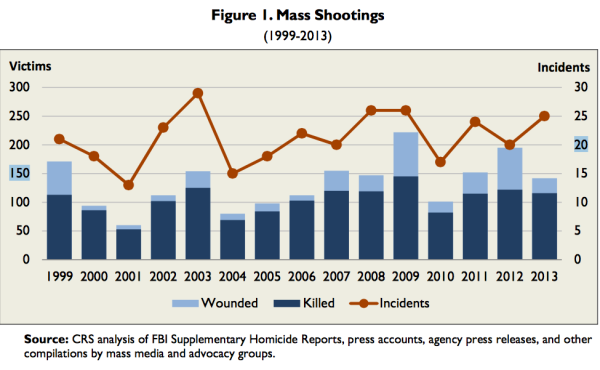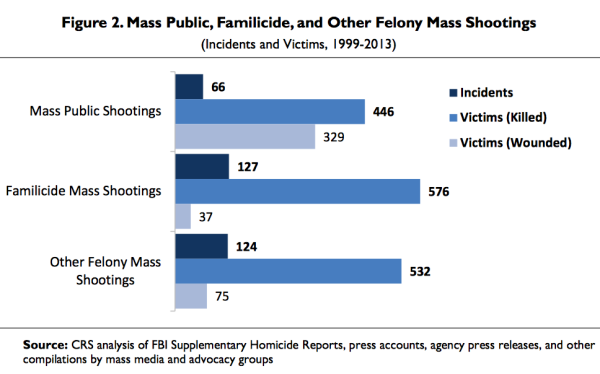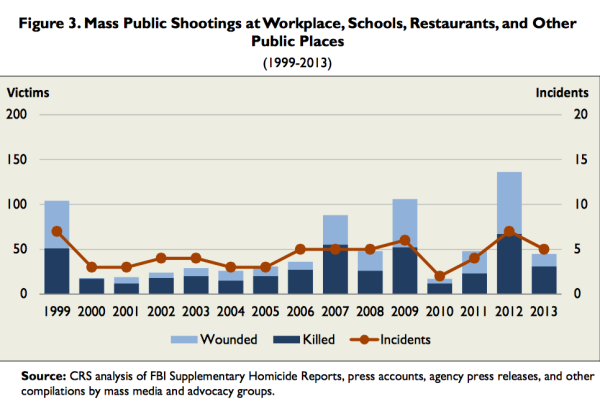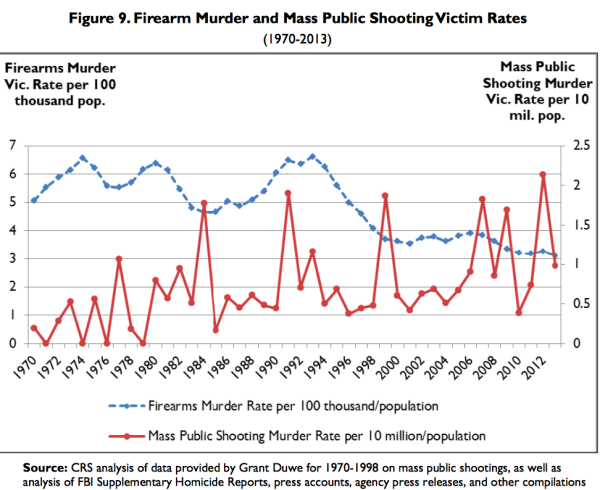About two weeks ago, the Congressional Research Service published a paper titled “Mass Murder with Firearms: Incidents and Victims, 1999-2013.” The primary author is William Krouse, a specialist in domestic security and crime policy. The CRS paper defines three kinds of “mass shootings”:
* “mass public shooting” means a multiple homicide incident in which four or more victims are murdered with firearms—not including the offender(s)—within one event, and at least some of the murders occurred in a public location or locations in close geographical proximity (e.g., a workplace, school, restaurant, or other public settings), and the murders are not attributable to any other underlying criminal activity or commonplace circumstance (armed robbery, criminal competition, insurance fraud, argument, or romantic triangle);
* “familicide mass shooting” means a multiple homicide incident in which four or more victims are murdered with firearms—not including the offender(s)—within one event, and a majority of the victims were members of the offender’s immediate or extended family, the majority of whom were murdered in one or more private residences or secluded, sparsely populated settings in close geographical proximity, and the murders are not attributable to any other underlying criminal activity or commonplace circumstance (e.g., armed robbery, criminal competition, insurance fraud, argument, or romantic triangle); and
* “other felony mass shooting” means a multiple victim homicide incident in which four or more victims are murdered with firearms—not including the offender(s)—within one event, in one or more locations in close geographical proximity, and the murders are attributable to some other underlying criminal activity or commonplace circumstance (e.g., armed robbery, criminal competition, insurance fraud, argument, or romantic triangle).
Incidents like Columbine, Sandy Hook, Virginia Tech and the Aurora, Colorado movie theater shooting are “mass public shootings”–the type of event that the public primarily fears.
Are we living through an “epidemic” of mass public shootings, as gun control advocates often claim? No. The CRS report offers multiple views of the data; this graph shows the total number of mass shootings of all three kinds from 1999 through 2013, with numbers of those killed or wounded each year. Click to enlarge:
There is little or no upward trend in the number of incidents.
This one compares mass public shootings with familicide mass shootings and other felony mass shootings. Mass public shootings are the least common of these three varieties, with only 66 incidents from 1999 through 2013. Click to enlarge:
This chart shows the number of mass public shootings at workplaces, schools, malls and other public places from 1999 through 2013, along with numbers of people killed or wounded. Click to enlarge:
There may be a slight upward trend, but only because of 2012; otherwise, the trend would be downward.
The CRS report notes that current concern about mass shooting events occurs in a context of a declining rate of homicides involving firearms:
As shown in Figure 9, the overall firearms-related murder victim rate increased in the 1970s, 1980s, and peaked in 1993. Since then, that murder rated has decreased, fluctuated moderately, or held steady for about the past two decades. From 1993 to 2013, the estimated firearms-related homicide victim rate per one hundred thousand of the population decreased from 6.62 to 3.10.
That bears repeating: between 1993 and 2013, the firearms-related homicide rate declined by more than 50%.
This chart plots the declining gun-related homicide rate per 100,000 against the mass public shooting victim rate per ten million people from 1970 through 2013:
While the homicide rate has fallen dramatically, the mass public shooting victim rate has increased somewhat. Note, however, what low rates we are talking about: it has fluctuated between zero and two deaths per 10 million people.
Why have fatalities due to mass shootings increased, albeit modestly, while overall firearms-related homicides have declined sharply? My guess is that the overwhelming publicity that has been given to mass shooting events in recent years has stimulated an unknown number of copycat crimes. In any event, no matter how you slice the data, the frequently-repeated claim that we are experiencing an “epidemic” of firearms violence or of mass shooting events is simply false.
Finally, the CRS report contains valuable observations on the NICS data base as it relates to mental health, improvements that have been made in recent years, and additional improvements that may be feasible. That is perhaps a subject for another day.




Notice: All comments are subject to moderation. Our comments are intended to be a forum for civil discourse bearing on the subject under discussion. Commenters who stray beyond the bounds of civility or employ what we deem gratuitous vulgarity in a comment — including, but not limited to, “s***,” “f***,” “a*******,” or one of their many variants — will be banned without further notice in the sole discretion of the site moderator.